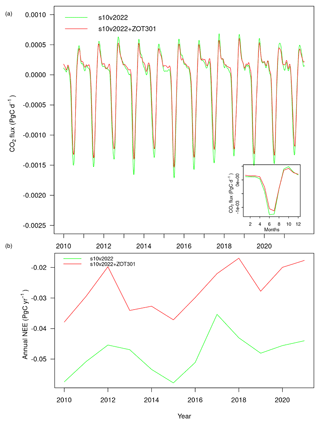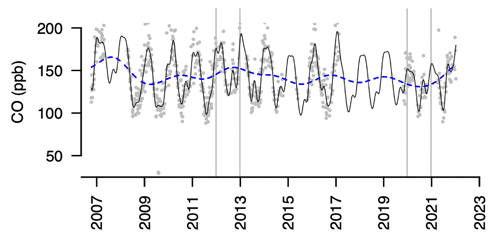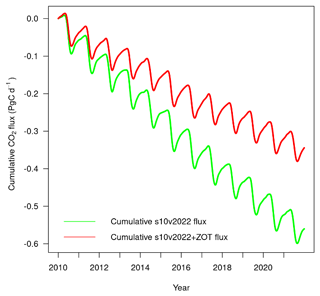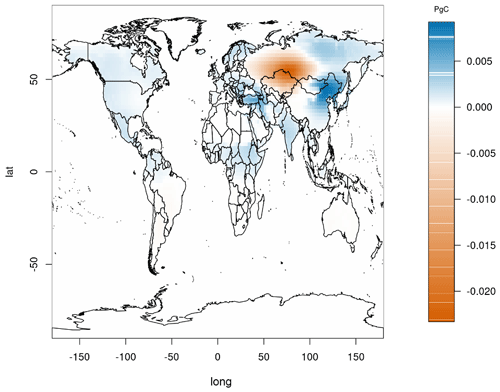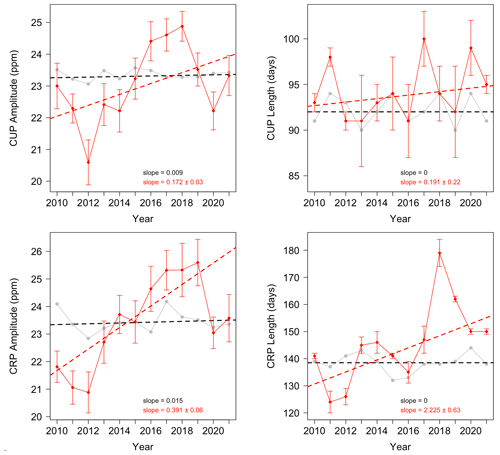the Creative Commons Attribution 4.0 License.
the Creative Commons Attribution 4.0 License.
Interannual variations in Siberian carbon uptake and carbon release period
Dieu Anh Tran
Christoph Gerbig
Christian Rödenbeck
Sönke Zaehle
Winters with higher-than-average temperatures are expected to enhance the respiratory release of CO2, thereby weakening the annual net terrestrial carbon sink. Using the 2010–2021 atmospheric CO2 record from the Zotino Tall Tower Observatory (ZOTTO) located at 60°48′ N, 89°21′ E, this study analyses interannual changes in the timing and intensity of the carbon uptake and release periods (CUP and CRP, respectively) over central Siberia. We complement our CO2 mole fraction analysis with the atmospheric inversion results to disentangle the effects of meteorological variability from the ecosystem's response to climate variability at a regional scale. From the observational data, CRP length and amplitude significantly increased between 2010 and 2021. Similarly, CUP length and amplitude have shown a positive but weaker trend since 2010, suggesting that increased CO2 release during cold months offsets the uptake during the growing season. This suggests that during 2010–2021, climate warming did not lead to higher annual net CO2 uptake despite the enhanced growing season uptake because cold-season respiration has also increased due to warming. The observational analysis further showed the influence of two extreme events: the 2012 wildfire and the 2020 heat wave. However, analysis of the inversion-derived net ecosystem exchange flux for the ZOTTO region did not reveal these trends or extreme events. Therefore, while ZOTTO data contain substantial information on the magnitude of the Siberian carbon balance (without further data from additional stations), we could not attribute a distinct contribution of ecosystems in the ZOTTO region of influence to the observed trends and extremes.
- Article
(6266 KB) - Full-text XML
- BibTeX
- EndNote
Siberian ecosystems play an important role in the global carbon budget. Whether they function as a future net carbon sink or source depends on seasonal climate variability and environmental change (Huemmrich et al., 2010; McGuire et al., 2012; Schuur et al., 2015). High-latitude ecosystems are generally temperature- or radiation-limited, and therefore, warming is the main control on the biogeochemistry and biogeophysics of high-latitude ecosystems and their associated feedback to regional and global climate (Box et al., 2019; Koven et al., 2011). On the one hand, climate warming promotes a reduction in spring snow cover, an earlier landscape thawing, an earlier onset of vegetation productivity, and longer growing seasons with increased vegetation productivity (Box et al., 2019). Climate warming has thereby contributed to high-latitude greening that has substantially enhanced photosynthetic carbon dioxide (CO2) uptake in the Northern Hemisphere over the past 5 decades (Ciais et al., 2019). On the other hand, warming-induced early-growing-season productivity can also increase cumulative evapotranspiration demand, which can reduce soil moisture levels and increase drought stress (Barnett et al., 2005; Buermann et al., 2013; Parida and Buermann, 2014; Yi et al., 2014). Recent satellite observations over northern ecosystems have shown widespread moisture-stress-induced decline in late growing season productivity, potentially offsetting productivity gains from warmer springs (Buermann et al., 2018), yet there is large uncertainty in the spatial pattern and magnitude of such seasonal compensations (Richardson et al., 2010). During the cold winter months, soil respiration is one of the key processes responsible for the variations in atmospheric CO2. Winters with higher temperatures are expected to increase microbial respiration, enhancing the respiratory release of CO2 and thereby weakening the annual net terrestrial carbon sink (Commane et al., 2017). How fast and strong these feedback processes (i.e. growing season uptake and cold-season respiration) operate and which will dominate is still an open and highly pressing scientific question.
Most current studies examining the duration of the carbon uptake period of high-latitude growing seasons primarily utilise flux measurements from eddy covariance (EC) combined with global vegetation models or data-based estimates (atmospheric inversions or satellite-derived data such as the normalised difference vegetation index (NDVI); e.g. Gu et al., 2022; Tang et al., 2021; Welp et al., 2016). However, one disadvantage of EC flux measurements is the occurrence of data gaps due to technical failures and challenges in continuing measurements in severe winter conditions, in addition to the need for filtering data collected in low-turbulence conditions (especially in the winter), compromising the data coverage of the EC technique. Gap-filling approaches for eddy covariance data exist, but they are associated with elevated uncertainties and may even lead to systematic biases. For example, a recent study showed that a widely used eddy covariance gap-filling method can cause systematic biases, leading to further uncertainties in carbon balance estimates (Vekuri et al., 2023). Furthermore, reliable long-term EC flux data (more than 10 years) are currently sparse over arctic and boreal regions. Additionally, EC flux measurements have a local footprint, whereas mole fraction data integrate the signal over a large area, being more representative of a regional spatial scale (Gloor et al., 2001).
Long-term atmospheric CO2 mole fraction observations are an alternative, reliable data source that has been used in numerous studies (e.g. Keeling et al., 1996; Pearman and Hyson, 1981; Bacastow et al., 1985; Myneni et al., 1997; Graven et al., 2017; Piao et al., 2008; Angert et al., 2005) to monitor the dynamics of carbon exchange in northern ecosystems. Most of these studies have concentrated on the amplitude of the seasonal cycle or the spring and summer boundaries of the growing season (Randerson et al., 1999; Piao et al., 2008, 2017), while less attention has been given to winter respiration. Importantly, the spatial scope of these studies predominantly focuses on the North American region, where two long-term measurement stations are located (Barrow Atmospheric Baseline Observatory (71°29′ N, 156°61′ W) and Alert (82°50′ N, 62°50′ W)), but few studies cover observations from Siberia. Indeed, despite the large significance of the Siberian domain as a climate “hot spot” for carbon storage in the global carbon cycle and its sensitivity to global warming, the Siberian region is only sparsely covered by continuous measurement stations, representative of changes on large spatial scales and decadal timescales. The global observation networks contain, at present, only very few stations for continuous monitoring of the full suite of greenhouse gases in the entire Siberian region north of 45° N (https://cosima.nceas.ucsb.edu/carbon-flux-sites/, last access: 7 July 2024), and most of them have now become inaccessible. In the framework of the project “Observing and Understanding Biogeochemical Responses to Rapid Climate Changes in Eurasia”, a scientific platform, the Zotino Tall Tower Observation (ZOTTO) facility, was constructed in central Siberia in 2006. Since 2009, at this site, continuous measurements of CO2, CH4, and a suite of additional atmospheric gases, as well as measurements of their isotopic composition, have been performed on a routine basis (Winderlich et al., 2010). Complemented by additional measurements of meteorology, chemically active trace gases, and aerosols, ZOTTO is a continental long-term atmospheric monitoring station which documents and helps to quantify the anticipated changes in biogeochemical cycling in this important but observation-poor region of the globe.
Here, we utilise ZOTTO long-term continuous atmospheric CO2 measurements from 2010–2021 to investigate the interannual variability in the seasonal cycle of the CO2 exchange of high-latitude Siberian ecosystems. First, we will assess the quality of the continuous CO2 mole fraction dataset at ZOTTO. We then quantify interannual changes in the timing (i.e. onset and termination) and intensity (i.e. amplitude and length) of the carbon uptake period (CUP) and carbon release period (CRP) and analyse their correspondence with climate anomalies. We finally complement our analysis with the results of an atmospheric inversion to disentangle the effects of meteorological variability in atmospheric tracer transport from ecosystem responses to climate variations.
2.1 Data
The mole fraction of atmospheric CO2 has been measured at the Zotino Tall Tower Observatory (ZOTTO) located in the middle taiga subzone (Yenisei region) of western Siberia on the left bank of the Yenisei River (60°48′ N, 89°2′ E; 114 m a.s.l.), as described originally in Winderlich et al. (2010). The continuous monitoring of CO2 in the atmospheric surface layer has been conducted since May 2009. Data from the EnviroSense 3000i gas analyser (Picarro Inc., USA) and the set of measuring equipment (including air intakes) situated on the metal mast at heights of 4, 52, 92, 156, 227, and 301 m were calibrated. The calibration system consists of four horizontally stored aluminium tanks (X2019 scale) (Table A1). To monitor the accuracy of the CO2 measurements at ZOTTO, one target tank has been measured every 200 h for 8 min, randomly distributed between two calibration cycles. These data are processed like the ambient air measurement data. After applying the calibration procedure as in Winderlich et al. (2010), the CO2 mole fraction of the target tank was found to be 404.64 ± 0.04 ppm for the entire period (Fig. 1). A comparison with target tank values from the Jena GasLab (404.60 ± 0.09 ppm) indicates a small but statistically insignificant bias in the observations and no discernible long-term trend in the measurements.

Figure 1Target tank time series (solid and dashed blue lines represent the mean ± standard deviation; solid grey line and grey shading is the Jena GasLab standard ± error).
To further establish the reliability of the continuous measurements, the measurements are compared to laboratory analyses of flask samples taken approximately weekly at 300 m height (Heimann et al., 2022). To reduce the mismatch between the timing and averaging periods of continuous and flask measurements, we employed the deconvolution approach described exemplarily for one flask measurement by Winderlich et al. (2010). The mean difference ± standard deviation between the in situ approximation and all currently available flask data is 0.086 ± 0.32 ppm for CO2 (Fig. 2).
2.2 Signal processing
This study utilised only the daytime measurements averaged daily over the period from 13:00 to 17:00 local time and measured at the height of 301 m. The use of such daytime-only values from the top of the ZOTTO tower ensures that the measurements are representative of the air in the entire boundary layer, thereby avoiding the domination of full daily averages by the high-CO2 mole fraction during nighttime due to the accumulation of CO2 in the shallow stable boundary layer as a result of the nighttime temperature inversion.
The variability in CO2 measurements at specific locations around the globe can, in general, be described as a combination of three signals: a long-term trend, a non-sinusoidal yearly cycle reflecting the change in the seasons, and short-term variations associated with meteorological variability that can last from several hours to several weeks as a result of local and regional influences. In this study, we use the CCGCRV (Thoning et al., 1989) curve-fitting application to separate these signals in the ZOTTO observations. CCGCRV (Thoning et al., 1989) is a curve-fitting application for a long-lived greenhouse gas (GHG) time series maintained at the Carbon Cycle Group of Climate Monitoring and Diagnostics Laboratory (CCG/CMDL) of the National Oceanic and Atmospheric Administration (NOAA, USA). The version of CCGCRV used here is applied as a stand-alone function in Python and is available from the NOAA CMDL ftp server at https://gml.noaa.gov/aftp/user/thoning/ccgcrv/ (last access: 7 July 2024). The result of the curve-fitting method is a function fit to the data, which approximates the annual oscillation and the long-term growth in the data, represented by a polynomial function and harmonics of a yearly cycle, respectively. The fit function includes digital filtering of the residuals from the fit by short-term and long-term cut-offs in units of time (i.e. days) to define interannual and short-term variations that are not determined by the function.
Since the curve-fitting method is sensitive to its parameter settings (Pickers and Manning, 2015), we created an ensemble of 100 curve-fitting settings with the three polynomials, with the number of harmonics varying from two to six. For each harmonic option, 20 short-term and long-term cut-off values were randomly chosen from 88 to 240 d and from 667 to 800 d, respectively (Table B1). To remove the impact of unreliable CO2 observations, which can strongly affect estimates of the seasonal cycle, for each ensemble member, any data lying outside the range defined by 3 times the normalised root mean square deviation relative to the smooth curve were iteratively discarded from the original time series until all outliers were removed (Kozlova et al., 2008). The percentage of the removal data is 2.4 % of the total data.
2.3 Estimation of the duration and amplitude of the carbon uptake period (CUP) and carbon release period (CRP)
In this study, we apply a method to estimate CUP and CRP presented in Kariyathan et al. (2023). We calculate the first derivative of the CO2 mole fraction with respect to time at every (daily) data point. To determine the CUP (CRP) onset and termination, we determined the point in time at which the time series of the first derivative crosses a threshold defined as a given percentage of the annual minimum (maximum) of the first derivative (Fig. 3). The difference in time between the defined onset and termination then represents the length of CUP (CRP). The absolute difference in mole fraction between these two points represents the amplitude of CUP (CRP). The rate of uptake (release) is then simply calculated by dividing amplitude by the length of CUP (CRP), assuming that the change in the curve shape of the season over the years is negligible. The use of the time derivative of a time series can provide a more robust estimate of the key dates that define the CUP and CRP without taking into account the changes in the shape of the seasonal curve compared to the conventional use of zero crossing date derived from the detrended CO2 seasonal cycle (Barlow et al., 2015) (more in Sect. 3.1).
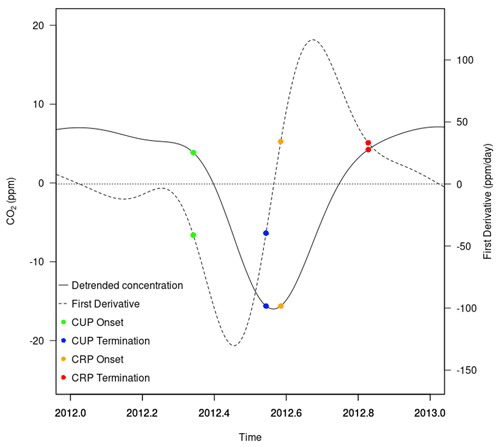
Figure 3A complete CO2 seasonal cycle for 2012 (solid line) and its first derivative representing the rate of CO2 uptake or release (dashed line). The blue and green points mark the time of 30 % of the minimum of the first derivative, while the red and orange points are 30 % of the maximum of the first derivative.
For the analysis shown here, we use a threshold of 30 % of the first derivative minimum. ZOTTO is a high-latitude, continental station; therefore, the seasonal cycle of CO2 is characterised by a flat maximum, showing one or even multiple peaks during the winter (Piao et al., 2008). This procedure results in several zero-crossings in the first derivative during the winter to spring seasonal transition. After conducting several tests with various threshold values, we decided that for the ZOTTO dataset, the value needed to be at least higher than 15 % to avoid multiple zero-crossings in the first derivative and thus clearly identify the timings of CUP. To assess the impact of the chosen threshold value on our results, we also varied the threshold between 15 %–30 %. The different thresholds influence the absolute length and amplitude of CUP without affecting the anomalies across years or the long-term trend (results not shown).
2.4 Jena CarboScope global inversion set-up
We derived spatiotemporal variations in the net ecosystem exchange (NEE) from long-term atmospheric CO2 measurements using a Bayesian atmospheric CO2 inversion of atmospheric transport (Jena CarboScope; Rödenbeck et al., 2003, updated). The inversion procedure uses the atmospheric tracer transport simulated by the TM3 model (Heimann and Körner, 2003) (resolution = 4° × 5 ° × 29 layers) driven by meteorological fields from the National Centers for Environmental Prediction (NCEP) reanalysis (Kalnay et al., 1996). Using the atmospheric tracer transport model to simulate the atmospheric CO2 field that would arise from a given flux field, the inversion algorithm finds the flux field that leads to the closest match between observed and simulated CO2 mole fractions. In addition, the estimation is regularised by a priori constraints meant to suppress excessive spatial and high-frequency variability in the flux field. The a priori settings do not involve any information from biosphere process models. Fossil fuel fluxes are fixed to accounting-based values (Jones et al., 2021). Ocean fluxes are fixed to the CarboScope estimates oc_v2022 (Rödenbeck et al., 2013, updated) based on an interpolation of pCO2 data from SOCATv2022 (Bakker et al., 2023).
We performed three inversion runs, listed in Table 1, spanning 2005–2021, i.e. including the 2010–2021 study period preceded by a 5-year spin-up time to account for any initialisation processes of the model. The three inversions differ in the set of atmospheric measurement stations used. The run labelled s10v2022 uses 78 globally distributed atmospheric monitoring stations which does not include any stations in Siberia (Fig. D1 and Table D1). To assess the impact of the contribution of the ZOTTO data on the estimated flux inferred by the inversion model, we additionally performed an inversion (s10v2022 + ZOT) in which we added the continuous atmospheric CO2 observations at 301 m from the ZOTTO station to the station set. The third inversion (s10v2022 + Allstations) also includes further atmospheric monitoring stations in Siberia, namely Tiksi (TIK; 71°60′ N, 128°89′ E; ranging 2011–2019), Noyabrsk (NOY; 63°43′ N, 75°78′ E; ranging 2005–2019), Demyanskoe (DEM; 59°79′ N, 70°87′ E; ranging 2005–2019), Karasevo (KRS; 58°25′ N, 82°42′ E; ranging 2004–2019), Azovo (AZV; 54°71′ N, 73°03′ E; ranging 2007–2019) (Fig. D1 and Table D1). From the s10v2022 + Allstations inversion, we only analyse the 2011–2019 period since this is the time when all involved atmospheric sites actually have data.
2.5 Flux area and derivation of CUP and CRP from posterior NEE fluxes
To understand to what extent the interannual variations in CUP and CRP observed in the ZOTTO data are explainable by regional ecosystem responses to interannual climate anomalies, we first determine the “region of influence” of the ZOTTO data on the NEE derived from the CarboScope inversion. We approximate this by calculating the 2010–2021 spatial root mean square (rms) of the climatology monthly difference between the inverted NEE without (s10v2022) and with (s10v2022 + ZOT) ZOTTO data included. The approximate region of influence of the ZOTTO data on estimates of net ecosystem exchange is then determined by 40 % of the average of all the monthly rms differences (red shading in Fig. D1). The ecosystem cover in this region of influence comprises Pinus sylvestris forest stands (about 20 m in height) on lichen-covered sandy soils. We then aggregated the NEE fluxes derived from the inversion with ZOTTO data included (s10v2022 + ZOT) for this region. The first derivative of the atmospheric CO2 data corresponds to the net land and ocean CO2 flux and, assuming an insignificant imprint of variations in fossil and ocean fluxes, to the NEE derived from the atmospheric inversion (see also Sect. 3). Therefore, similar to the process applied for the observed dataset, to determine the timings and length of CUP (and CRP) from posterior NEE flux, all the data points before and after the flux minimum (maximum) when the flux value is less than 30 % of the minimum (maximum) NEE were selected. The amplitudes of CUP and CRP are the integrals of the fluxes between the onset and termination of CUP and CRP.
2.6 Partial correlations with climate anomalies
We calculated partial correlation coefficients between seasonal temperature anomalies and the timing and intensities (i.e. length and amplitude) of CUP (and CRP). To quantify the decadal change in the partial correlation, we controlled for the effects of precipitation and cloud cover. We used monthly climatic data (temperature (in °C), precipitation (in mm d−1), and cloud cover (in percent)) at a spatial resolution of 0.5° for 2010–2021 from ERA5 reanalysis (Hersbach et al., 2020). The region of influence used for this correlation analysis (red shading area in Fig. D1) was derived from Sect. 2.5, with additional spatial weighting by the annual gross primary production (GPP) from the observation-derived upscaling product by Jung et al. (2011) to focus the integration of the climate data on the vegetated areas and remain independent from the potential biases of the inversion.
The ZOTTO daytime data at 301 m used in this study are presented in Fig. 4a. The 2010–2021 average amplitude of the seasonal cycle at ZOTTO calculated from CCGCRV smoothed mole fraction is 25.5 ppm, after subtracting the linear part from the harmonic fitting. This number is comparable with previously reported values of 26.6 ppm at ZOTTO in the year 2007 (Kozlova et al., 2008). Due to its continental location, the amplitude at ZOTTO is larger than at other tall tower sites with stronger marine influence, e.g. Białystok, Poland, with 23 ppm (Popa, 2007), or Ochsenkopf, Germany, with 15.5 ppm (Thompson et al., 2009) at the uppermost tower levels (300 and 163 m a.g.l., respectively). The seasonal amplitude of the ZOTTO mole fraction data is also more prominent than that of the marine boundary layer product (MBL) (NOAA, 2022), which is based on measurements from National Oceanic and Atmospheric Administration (NOAA) Cooperative Global Air Sampling Network sites, where samples are predominantly of well-mixed marine boundary layer but at the same latitude as ZOTTO and away from anthropogenic and strong natural sources and sinks (Fig. 4b). A clear pattern becomes evident: during winter, CO2 is released over continents by biospheric respiration and anthropogenic emissions, while the ocean may even counteract the global CO2 increase through increased CO2 solubility in cold water. Figure 4 also shows the CO2 uptake during summer. The photosynthetic uptake from the biosphere over the continent amplifies the summer minimum in the CO2 data and produces an offset relative to the MBL data. Moreover, a time shift in the summer minima can be seen between ZOTTO and the maritime background. This time shift is induced by the transport of the CO2-depleted air from the continents towards the ocean. Annual CO2 mole fractions at ZOTTO are higher, and the interannual CO2 growth rate exhibits a stronger variability than the MBL. This indicates the strong continental influences of ZOTTO location in central Siberia. Therefore, it is important to investigate the trends of different components of the annual seasonal cycles, as well as the implications for the continental carbon cycle.
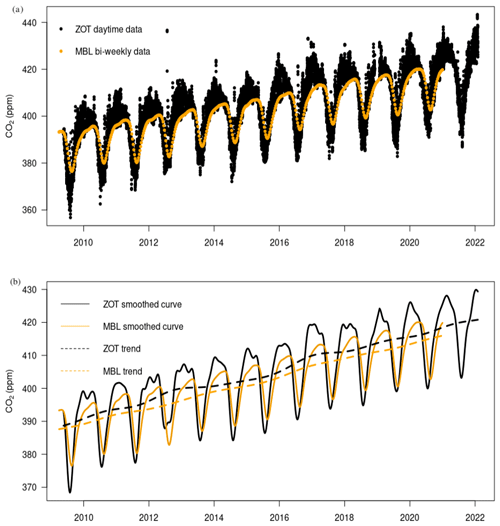
Figure 4(a) Daytime CO2 time series of the continental ZOTTO station in comparison to the bi-weekly marine boundary layer (MBL). (b) Time series of panel (a) smoothed by the Thoning et al. (1989) algorithm.
3.1 Interannual variation in the timing and the intensity of the carbon release period (CRP) and carbon uptake period (CUP)
The analysis of data for the 11 years of observations at ZOTTO reveals that the annual minimum of CO2 in the individual years of the smoothed time series was registered on one of the days during the period from 26 July to 3 August, whereas the annual maximum was registered within a wider time period from December 23 to January 29 (Fig. 4). The mean onset and termination dates for the CUP over 2010–2021 are 1 May and 20 July, respectively. Similarly, the mean onset and termination for the CRP are on 2 August and 2 January.
There were no significant trends in the timing of CUP (i.e. onset and termination) (Fig. 5). This finding is opposite to the earlier studies by Piao et al. (2008) and Barichivich et al. (2012), showing results from the 20-year atmospheric CO2 mole fraction data record from high-latitude stations in Alaska, USA, and Canada and the CarbonTracker data assimilation system. These studies found a trend towards an earlier onset of the autumn to winter carbon dioxide build-up for the period 1990–2010, suggesting a shorter net carbon uptake period. Our finding is similar to that of Liu et al. (2018), in which they show a reduction in the response of decomposition to warming for the 1997–2011 period, suggesting that autumn warming in boreal and arctic ecosystems no longer advances the end of the carbon uptake period as previously suggested. Notwithstanding, it is important to take into account the shorter time span of the ZOTTO dataset when making comparisons to results from other studies with longer measurement records. The absence of a significant trend in the timings of CUP (i.e. onset and termination) occurs in light of significant interannual variability in the timing of these events. For instance, there was an abnormally early onset of CUP in 2020 (Fig. 5). This finding will be further analysed later in this section. Figure 5 also shows a significant increasing trend in the timing of release termination, suggesting the termination of CRP was happening later and later during the 11-year study period.
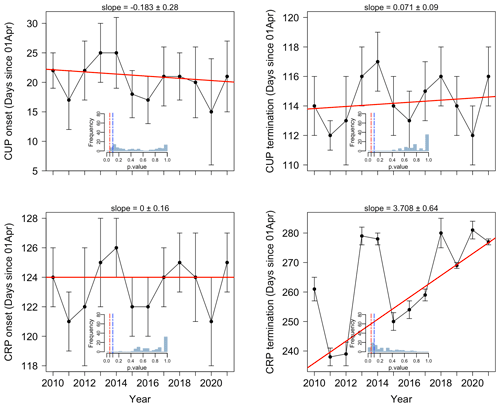
Figure 5Time series of the timings of the CRP and CUP onset and termination. Inset histograms show the frequency of p values of the Theil–Sen regressions of the 100-member curve-fitting ensemble, with dashed vertical red and blue lines, respectively, indicating the 0.05 and 0.1 significant difference from 0 of the slopes. Error bars are the standard deviations from the mean of the 100-member curve-fitting ensemble.
We found a significant negative correlation between spring (March–May, MAM) temperature anomalies and the onset of CUP (Fig. 6) (R= −0.52; p<0.05). Similarly, summer temperature (June–August, JJA) anomalies were negatively correlated with the onset of the CRP (Fig. 6) (R= −0.48; p<0.05). The termination of CRP is positively correlated with the proceeding autumn (September–November, SON) temperature anomaly (R=0.53; p<0.1) (Fig. 6).

Figure 6The partial correlation coefficient between seasonal temperature anomalies and the timing of release start (or uptake termination), release termination, and uptake onset controlling for the effects of precipitation and cloud cover over the 2010–2021 period. The timings are correlated with the seasons they fall in and also with three preceding seasons (demonstrated as the length and direction of the arrow of the respective colour). We calculate the partial correlations by selecting every subset of 10 years in the 11-year 2010–2021 period (omitting 1 year in each calculation) and taking their standard deviation as the error bar. Errors bars are small and therefore not visible in this figure. Bars marked with asterisks (* and ) indicate that the partial correlation coefficient is significant at p<0.1 and p<0.05, respectively.
There were clear and significant increasing trends in the release length and release amplitude (at p<0.1 and p<0.05 level, respectively) (Fig. 7). For the CUP, both the uptake length and amplitude also increased significantly (at p<0.05 level and 0.1 level, respectively) over the study period. The trend in the amplitude was interrupted by 2 years (2012 and 2020) with anomalously small amplitude. Taken together, these trends provide evidence for the amplification of the seasonality of atmospheric CO2 at ZOTTO. There were abnormal decreases in both CUP and CRP amplitude in 2012 (Fig. 7). Without the abnormal years 2012 and 2020, the trends of CUP and CRP amplitude would be 2.43 and 1.93 ppm yr−1, respectively. Our finding is consistent with Graven et al. (2013), comparing 2009–2011 aircraft-based observations of CO2 above the North Pacific and Arctic oceans to earlier data from 1958 to 1961 and found that the seasonal amplitude at altitudes of 3 to 6 km increased by 50 % for high latitudes. Forkel et al. (2016) combined observations and models showing that climate warming has caused an increase in carbon uptake amplitude as a result of the global CO2 fertilisation effect. This led the uptake rate of carbon to increase faster than its respiratory release rate from the terrestrial biosphere. However, in this study, the slopes or the rates of uptake and release stay the same despite both the amplitude and length of CUP and CRP increasing significantly over the 11-year study period. This could suggest that the increase in either the amplitude or the length of CUP and CRP observed at ZOTTO is not strong or dominant enough to alter the rate of uptake and release over the 11-year period.
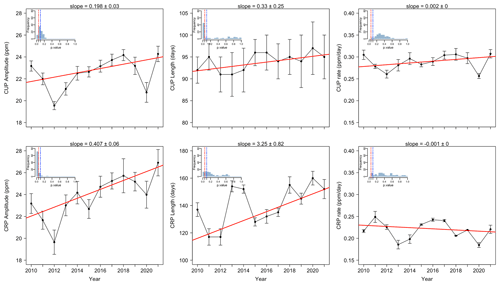
Figure 7Time series of the length and amplitude of CRP and CUP. Inset histograms show the frequency of p values of the Theil–Sen regressions of the 100-member curve-fitting ensemble, with dashed vertical red and blue lines, respectively, indicating the 0.05 and 0.1 significant difference from 0 of the slope. Error bars are the standard deviations from the mean of the 100-member curve-fitting ensemble.
Positive correlations between spring temperature and CUP's amplitude and length (R=0.56, p<0.05 and R=0.7, p<0.05, respectively) were stronger than those between autumn and winter temperatures and CRP's amplitude and length (R=0.52, p<0.05 and R=0.19, p<0.05, respectively) (Fig. 8). The summer (JJA) temperature anomaly was also significantly negatively correlated with CUP amplitude (Fig. 8).

Figure 8The partial correlation coefficients between seasonal temperature anomalies and the amplitude and length of CUP and CRP, controlling for the effects of precipitation and cloud cover over the 2010–2021 period. The amplitude and length are correlated with the season when CRP and CUP end and also with three preceding seasons (demonstrated as the length and direction of the arrow of the respective colour). We calculate the partial correlations by selecting every subset of 10 years in the 11-year 2010–2021 period (omitting 1 year in each calculation) and taking their standard deviation as the error bar. Errors bars are small and therefore not visible in this figure. The asterisks (* and ) indicate that the partial correlation coefficient is significant at P<0.1 and P<0.05, respectively.
Our correlation analyses suggest that warmer temperatures during the spring growing season are linked to earlier spring phenology in temperate and boreal forests (Fig. 6), as also shown in Gu et al. (2022). These results are also consistent with Barichivich et al. (2012), who used gridded daily temperature from 1950 to 2011 and atmospheric CO2 mole fraction data from high-latitude observing stations and the CarbonTracker assimilation system, showing that higher late summer/early autumn temperatures lead to an earlier onset of autumn carbon release while higher growing season temperatures lead to an earlier onset of spring carbon uptake. This finding coincides with an unprecedentedly strong and persistent heatwave in the winter to spring of 2020 in Siberia that resulted in an early onset of CUP, as seen in Fig. 5. A warmer spring could potentially increase the carbon uptake amplitude, as seen in Fig. 8. However, during 2020 when the Siberian winter-to-spring heatwave occurred, there was only an increase in the CUP length due to the early spring onset but not in the CUP amplitude (Fig. 7). Our finding matches the results from the recent study of Kwon et al. (2021), where they found that during the Siberian 2020 heat wave, the warming-induced enhanced photosynthetic CO2 uptake in spring was offset by a larger reduction in CO2 uptake in late summer due to soil moisture deficit, resulting in the mean annual CO2 uptake over Siberia slightly lower than the average of the previous 5 years. The warmer 2020 spring conditions promoted increased vegetation growth, which, in turn, contributed to fast soil moisture depletion, causing plants to close their stomata to conserve water. This led to reductions in evapotranspiration and photosynthetic activity, thereby reducing carbon uptake from the atmosphere in the later summer. Additionally, with an early onset of the growing season and the warm temperatures during summer, the active soil layer will tend to get deeper in late summer and autumn (Fisher et al., 2016). This will, in turn, lower the water table and, in some cases, remove the soil water pool far enough from the rooting zone to cause a draught effect (Costa et al., 2023).
The Siberian wildfire in the late summer of 2012 resulted from dryness. Low moisture pre- and post-fire could have led to the reductions seen in both CUP and CRP amplitude in 2012. Indeed, for much of 2012, there was an abnormally high summertime CO observed at ZOTTO (Fig. E1), which would confirm a very strong fire season. There are clear increasing trends in the CUP and CRP amplitude, but it cannot be ruled out that extremes and the legacy effect of ecosystem recovery from the 2012 wildfires impact these trends to a significant degree (i.e. the increasing trend that we observed might not have been as strong and significant as without the legacy effect). In the same analysis derived from HPspline curve fitting (Figs. C1 and C2), the CUP amplitude trend does not have such as strong “recovery” after 2013. The legacy effect, thus, perhaps only occurred in 2013.
For our study, we applied an alternative method that derived seasonal components from the first derivative of the mole fraction data, as in Kariyathan et al. (2023) (described in more detail in Sect. 2.3). This method was shown to give a more robust estimation of CUP duration than the conventional “zero-crossing method” (Barlow et al., 2015). Previous studies have used the zero-crossing times (i.e. the downward and upward CO2 zero-crossing dates as the day on which the detrended curve crossed the zero line from positive to negative and from negative to positive, respectively) and their difference as proxies for the onset, termination, and duration of the net CUP. This approximation assumes that the shape of the seasonal cycle does not change significantly, and hence, a change in the phase at one point (e.g. maximum) of the seasonal cycle provides information on phase changes at other points (Barichivich et al., 2012). However, the zero-crossing times may not be the best proxy if the shape of the seasonal cycle changes substantially from year to year or when the seasonal cycle is not symmetric around the maximum/minimum (skewed seasonal cycle) (Barlow et al., 2015; Kariyathan et al., 2023).
The limitation of the CCGCRV or other existing harmonic-based curve-fitting methods is their limited ability to properly address non-stationary processes, which is most noticeable during rapidly changing environmental conditions (e.g. drought and heatwave) that affect the amplitude and phase of the seasonal time series. However, considering this limitation, the CCGCRV-derived smoothed time series for ZOTTO data still represented anomalous seasons (Fig. 4b). To ensure that results are not unduly influenced by the mathematics underlying this specific curve-fitting program, we repeated our analysis using detrended data derived from an alternative curve-fitting program – HPspline (Keeling et al., 1986) (Figs. C1 and C2). There were no significant differences in seasonal signals between the two curve-fitting programs.
3.2 Analysis from Jena CarboScope global inversion
Before analysing posterior NEE fluxes, we compared the trend and interannual variability in the timing and intensity of CUP and CRP derived directly from observed data with the atmospheric mole fraction simulated by TM3 based on the CarboScope posterior NEE fluxes from the inversion (s10v2021 + ZOT) to ascertain that the inversion captures the observed patterns discussed in Sect. 3.1 (more in Appendix H). In general, the inversion is capable of well reproducing the interannual variations and trends resulting from the combination of variability in atmospheric transport (derived from meteorological variations) and regional ecosystem flux responses to climate variations (Figs. H1–H6). This gives us more confidence in the posterior NEE fluxes derived from the model that we will now use to further assess the signals and variations we have seen in the observation analyses.
In Sect. 3.1, we have shown that the variations in CUP and CRP timings and intensity derived from mole fraction data correlate with climate anomalies in the region. The flux anomalies inferred from the inversion using the ZOTTO data averaged for the region of influence broadly lack similarity in interannual variability between the timing of CUP and CRP derived from mole fraction data, with the notable exception of the CUP termination, while the trends over the 11-year period are not statistically significant in both inversion-based NEE and mole fraction data (Fig. 9). One exception is that the posterior NEE shows early onset of CUP in 2020, even though the magnitude of this early onset is not as large as seen in the mole fraction analysis derived from ZOTTO measurements.
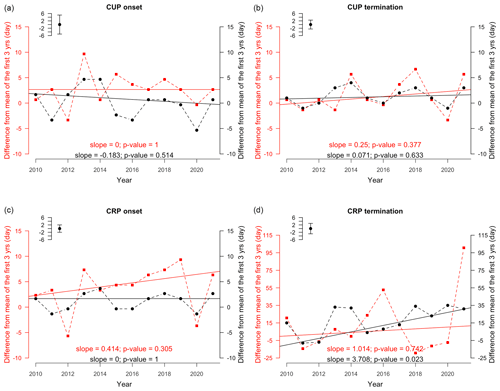
Figure 9Time series of the timing of CRP and CUP derived from observational atmospheric mole fractions (black circle) and regional fluxes (red square). The small bar plot on the top left of each panel indicates the 2010–2021 average error in the observational analysis. We calculated the difference from the mean of the first 3 years (in days) to take into account the offset in scale between the two analyses, therefore, better visualise the interannual variations in each analysis.
The CUP and CRP lengths derived from NEE fluxes are shorter compared to those derived from the atmospheric CO2 mole fractions resulting from the difference in variabilities in the timing in onset and termination of CUP and CRP between the two analyses (Fig. 10). The anomalies of 2012 and 2020 shown in the uptake and release amplitudes as inferred from the observed mole fractions are not apparent when analysing the regional NEE fluxes. This difference occurs despite the fact that the 2012 and 2020 anomalies do exist in the atmospheric CO2 mole fraction simulated from the fluxes estimated by the inversion (Fig. H2). One possible interpretation of this finding is that the regional NEE fluxes were not significantly influenced by the wildfire and heat wave in 2012 and 2020, respectively. This suggests that for the inversion, there is not sufficient constraint on interannual regional flux variations to attribute the strong mole fraction anomalies in 2012 and 2020 to regional signals – instead, the inversion suggests that these are likely the consequence of a hemispheric instead of a central Siberian signal. We cannot exclude the possibility that the area of influence of the ZOTTO data, defined in this paper based on the 11-year average imprint of ZOTTO in the inversion, is not well representing the influence areas under these anomalous climate conditions, leading to an erroneous attribution of the flux anomaly to hemispheric scales. To further investigate and confirm this, a footprint analysis from a transport model or a regional inversion study during these abnormal occasions or the use of a multiple-factor inversion (such as the NBE-T inversion by Rödenbeck et al (2018), which estimated the response of net biome exchange (NBE) to climate anomalies using linear regression against air temperature anomalies based on long-term CO2 observations) is needed, which is outside the scope of this paper.

Figure 10Time series of the amplitudes and lengths of CRP and CUP derived from atmospheric mole fractions (black circle) and regional fluxes (red square). The small bar plot on the top left of each panel indicates the 2010–2021 averaged error in the observational analysis.
We also compared our main analysis (i.e. timing and intensity of CUP and CRP) among all three inversions listed in Table 1. In terms of the timing analysis, apart from CRP termination, the trends among all runs are quite similar (±0.2) (Fig. G1). The year-to-year variations seem to become more prominent as more stations are added into the inversion. CRP termination derived from the run with added ZOTTO data has an abnormal value in 2021. With regard to the intensity analysis (Fig. G2), the uptake and release amplitudes decrease (in absolute terms) as more stations are added into the model, and the length of these periods also decreases.
To understand more about the inferred NEE fluxes that we used in the above analyses, we will now compare the two inversions using station sets s10v2021 and s10v2021 + ZOT. The assessment of the impact of the ZOTTO station on the inverted NEE (based on the comparison between our different Jena CarboScope inversions with and without ZOTTO) can help to separate the contribution of the influence of meteorological variability and regional ecosystem NEE on the observed mole fraction.
The 2010–2021 averaged annual Northern Hemisphere (NH) (>30° N) NEE values for the inversions using station sets s10v2021 and s10v2021 + ZOT are of comparable magnitude with −0.32 and −0.31 PgC yr−1, respectively. The use of ZOTTO data in the inversion reduces the seasonal amplitude of the NEE within the area of influence of ZOTTO, as defined in Sect. 2 (Fig. 11). The 11-year (2010–2021) averaged annual NEE values of the constrained region (Fig. D1) for the inversions using station sets s10v2021 and s10v2021 + ZOT are −50 and −30 TgC yr−1, respectively. The percentage difference in the 2010–2021 cumulative NEE flux between estimates with and without the ZOTTO station dataset into the global inversion (i.e. s10v2022 vs. s10v2022 + ZOT) is ∼ 39 % (Fig. G3), i.e. weaker regional uptake when using ZOTTO data. Since the global carbon budget is closed at interannual timescales, adding ZOTTO data to the inversion altered the estimated carbon uptake within the rest of the world accordingly to conserve mass, leading to higher carbon uptake spread widely across the NH tropical and mid-latitude region of 20–50° N (Fig. G4). To compare the interannual variability in the NEE within the defined region of influence, we also calculate the average NEE for each year and then calculate the standard deviations (SDs) of these values. The SD values of the inversions using station sets s10v2021 and s10v2021 + ZOT are 6 and 9 Tg C yr−1, respectively. Adding ZOTTO data increases the variability attributed to the region. The ZOTTO data correct for biases in the standard inversion and lead to a more correct representation of amplitude (i.e. gross photosynthesis − respiration) and the imbalance decadal NEE, therefore better optimising the flux in the constrained region.
Our analysis of the continuous record of CO2 mole fractions at ZOTTO shows the high quality of the data with no systematic error over the period 2009–2022. The data reveal that the CO2 uptake and release amplitude and length significantly increased from 2010 to 2021, where the increasing trend in CRP amplitude is bigger than that of the CUP. This pattern corresponds well to the global trend of increased intensity of the seasonality in northern hemispheric carbon exchange. The data show a strong negative correlation between spring temperature and CUP onset, as well as between late summer temperature and CUP termination/CRP onset, suggesting a strong regional influence of local climate on the observed mole fractions. However, there were no significant trends in the timing of CO2 uptake and release in our 11-year study period.
We have shown through mole fraction analyses the influences of two extreme events, the wildfires in 2012 and the 2020 heat wave. However, the inversion-based NEE fluxes using the ZOTTO data did not show the flux anomalies deriving from the Siberian wildfires in 2012 and the 2020 Siberian heat wave, as seen in the observational analyses. The interannual variations from the NEE flux analysis were different from that from the mole fraction analyses. This could suggest that the variabilities that are only seen in the atmospheric mole fraction analyses could be derived from outside the defined area of influence of ZOTTO. However, we cannot rule out the possibility that the weight of ZOTTO data in the inversion compared to other regions of the world and the absence of sufficiently long, continuous CO2 mole fraction measurements in other Siberian regions prevent a robust attribution of Siberian variability by the inversion. Possibly, the quantification of regional fluxes could be improved using satellite data collected during summer months when the observing geometry is favourable but also during other months via an improved higher-resolution regional transport model or the use of additional constraints in the inversion such as climate anomalies (Rödenbeck et al., 2018). Due to the sparseness and uneven distribution of the monitoring surface networks, it is still debatable whether a higher-resolution regional transport model alone may better constrain regional fluxes.

Figure C1Time series of the timing of CRP and CUP's onset and termination using two different curve-fitting methods to smooth the atmospheric mole fraction data, with Thoning et al. (1989) in black and HPspline in orange. The HPspline-derived smoothed concentration curve is stiffer than Thoning et al. (1989) and less sensitive to parameter settings. Therefore, we created an ensemble of four extreme HPspline settings for which the smoothing factor varies between 30, 500, 1000, 11 000, and 99 000.

Figure C2Time series of the intensity of CRP and CUP (i.e. amplitude and length) using two different curve-fitting methods to smooth the atmospheric mole fraction data, with Thoning et al. (1989) in black and HPspline in orange. The HPspline-derived smoothed concentration curve is stiffer than Thoning et al. (1989) and less sensitive to parameter settings. Therefore, we created an ensemble of four extreme HPspline settings for which the smoothing factor varies between 30, 500, 1000, 11 000, and 99 000.

Figure D1Locations of the stations in the s10v2022 set (purple triangles), ZOTTO (red dot), and the additional six stations (orange triangles) in the s10v2021 + Allstations set. The red shading is the averaged influencing region for the ZOTTO observational dataset.
Table D1Atmospheric CO2 measurement stations used in the inversion. The institutions are referenced as follows: AGH is the University of Science and Technology, Poland; BGC is the Max Planck Institute for Biogeochemistry, Germany (Thompson et al., 2009); CSIRO is the Commonwealth Scientific and Industrial Research Organisation (Francey et al., 2003); CNR-ISAC is the Italian Air Force Meteorological Service, Institute of Atmospheric Sciences and Climate (Colombo et al., 1994); EC is Environment Canada (Worthy, 2003); Empa is the Swiss Federal Laboratories for Materials Science and Technology; FMI is the Finnish Meteorological Institute (Kilkki et al., 2015); JMA is the Japanese Meteorology Agency (Watanabe et al., 2000); KMA is the Korea Meteorological Administration (Republic of Korea) (Cho et al., 2007); LSCE is the Laboratoire des Sciences du Climat et de l'Environnement, France (Monfray et al., 1996); NIES is the National Institute for Environmental Studies, Japan (Tohjima et al., 2008); NIPR is the National Institute of Polar Research and Tohoku University, Japan (Morimoto et al., 2003); NOAA is the National Oceanic and Atmospheric Administration/Earth System Research Laboratory, USA (Conway et al., 1994); RSE is the Ricerca sul Sistema Energetico, Italy; RUG is the Centre for Isotope Research, Rijksuniversiteit Groningen, the Netherlands; SAWS is the South African Weather Service (Labuschagne et al., 2003); SIO is the Scripps Institution of Oceanography (Keeling et al., 2005; Manning and Keeling, 2006); UBA is the Umweltbundesamt, Germany (Levin et al., 1995); UEA is the University of East Anglia, UK. Note: d is for in situ, daytime selected; f is for flask; h is for in situ, all hours; n is for in situ, nighttime selected.
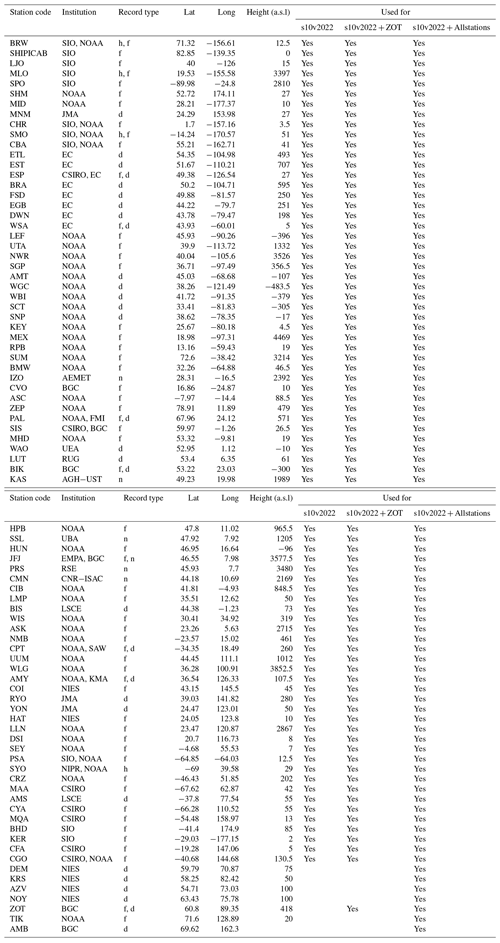

Figure F1Observed CO2 mole fraction time series of ZOTTO (grey dots) and corresponding inversion forward simulation (s10v2022 + ZOT) (light salmon dots); smoothed CO2 concentration time series of ZOTTO-observed data (black line) and inversion model forward outputs (red line) obtained from the Thoning et al. (1989) algorithm using short-term cut-off = 88 d, long-term cut-off = 667 d, number of harmonics = 2, and degree of polynomial = 3.
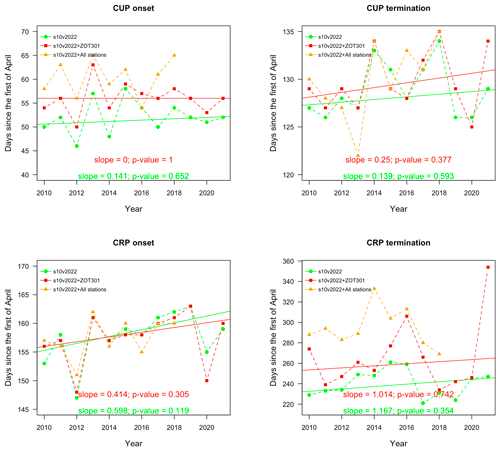
Figure G1Time series of the timing of CRP and CUP derived from three inversions with different station sets are listed in Table 1.
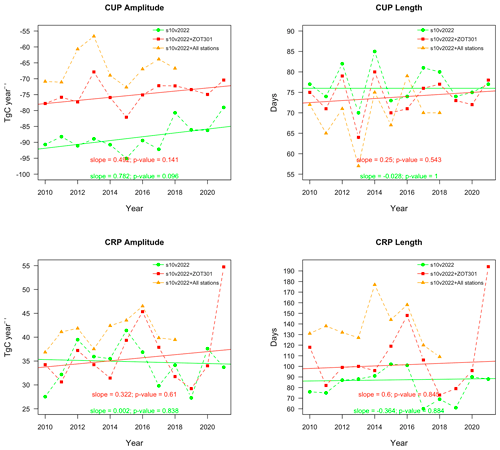
Figure G2Time series of the intensities of CRP and CUP derived from three inversions with different station sets are listed in Table 1.
The simulated mole fraction data obtained from the inversion model underwent the same processing steps as the observed data, following the procedures described in Sect. 2.2 and 2.3 in the main text. The simulated mole fraction data have been calculated by forward simulation with the atmospheric tracer transport model TM3 driven with re-analysed meteorological data. Surface CO2 fluxes supplied to the model are the inverse flux estimates based on atmospheric observations and the same transport model. By construction, therefore, the simulated atmospheric CO2 mole fraction fields optimally fit the measurements at the set of observation sites used. In other words, the inversion has been constrained by exactly the same observations. Comparing the simulated mole fraction data to observations is essential to check how well inversion constrains the variabilities seen in the observations.
The trends in the intensity (i.e. length and amplitude) and the timing (i.e. onset and termination) of CUP and CRP derived from inversion forward mole fraction data are similar to those from observed data, despite smaller offsets in the absolute timings of onset and termination (Figs. H1 and H2). The interannual variations in CUP and CRP amplitude derived from observed data and model forward mole fraction are consistent. The CO2 time series derived from the inversion captures the observed anomalies in the years 2012 and 2020. Indeed, when plotting observation-based analysis against forward output analysis (Figs. H3 and H4), the Theil–Sen linear fit slope between the two for CUP and CRP amplitude is 1.0 (R2 = 0.7) and 0.9 (R2 = 0.6), respectively. The inversion-based result also broadly captures the timing of CUP and CRP with few exceptions in the CRP termination date. This could be explained by the fact that the inversion-based mole fraction data have less short-term variability (Fig. F1) due to under-represented synoptic variability in the atmospheric transport model, and the smoothed mole fraction data obtained through the Thoning et al. (1989) method are also lower compared to that from the observed data. In general, the inversion is capable of reproducing internal variations and trends well. This gives us more confidence in the posterior NEE fluxes derived from the model that we will now use to further assess the signals and variations we have seen in the observation analyses. We also check the prior mole fraction data outputs of the inversion. The CUP and CRP calculated from the prior mole fraction data, which is the mean seasonal cycle of an inversion, contain very small year-to-year variations in the CO2 flux, and in particular, there is no interannual variation similar to the posterior mole fraction analysis (Figs. H5 and H6).

Figure H1Time series of the timing of CRP and CUP derived from observation (in black) and model forward (s10v2022 + ZOT simulation) (in red) mole fraction analysis.
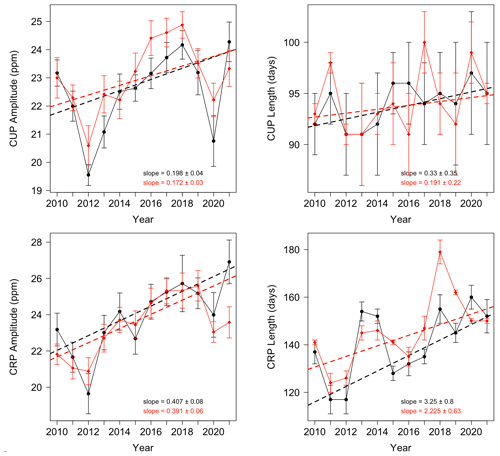
Figure H2Time series of the amplitudes and lengths of CRP and CUP derived from observation (in black) and model forward (s10v2022 + ZOT simulation) (in red) mole fraction analysis.
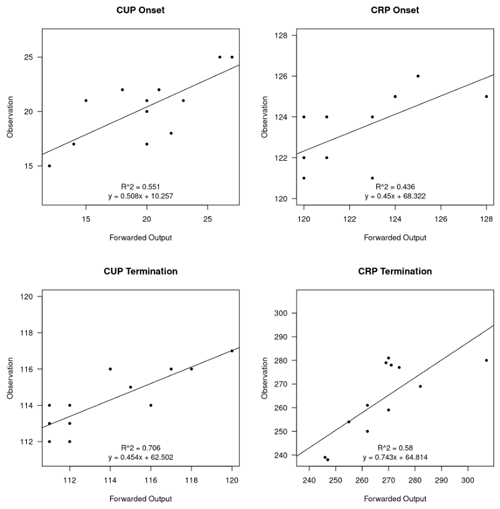
Figure H3Regression of the timing of the CUP and CRP onset and termination derived from observational data against model forward output mole fraction.

Figure H4Regression of intensity (i.e. amplitude of length) of CUP and CRP analyses derived from observational data against model forward output mole fraction.

Figure H5Time series of the timing of CRP and CUP derived from prior (in grey) and posterior (in red) model forward (s10v2022 + ZOT simulation) mole fraction analysis.
The CO2 atmospheric mixing ratios are available on request at https://doi.org/10.17617/3.YBPFG2 (Tran et al., 2024). More information can be provided by Dieu Anh Tran (atran@bgc-jena.mpg.de). ZOTTO CO2 flask data are available at https://doi.org/10.17617/3.AXLVK0 (Jordan et al., 2023).
DAT and SZ designed the study. DAT carried out the data curation and analysis. CG and CR advised on the use of the CarboScope model, and DAT performed and analysed the simulations. DAT prepared the paper with contributions from all co-authors.
At least one of the (co-)authors is a member of the editorial board of Atmospheric Chemistry and Physics. The peer-review process was guided by an independent editor, and the authors also have no other competing interests to declare.
Publisher’s note: Copernicus Publications remains neutral with regard to jurisdictional claims made in the text, published maps, institutional affiliations, or any other geographical representation in this paper. While Copernicus Publications makes every effort to include appropriate place names, the final responsibility lies with the authors.
We acknowledge funding by the Max Planck Society to support the installation and maintenance of the ZOTTO until February 2022. Dieu Anh Tran acknowledges support from the International Max Planck Research School for Global Biogeochemical Cycles (IMPRS). For servicing the installed set-up at the ZOTTO station, we deeply appreciate the work of Alex Panov, Anatoly Prokushkin, and their colleagues from the Sukachev Institute of Forest in Krasnoyarsk, Russian Federation. Technical assistance for the upkeep of the instrumentation at MPI-BGC is also acknowledged, specifically Jošt Lavrič, Thomas Seifert, Steffen Schmidt, Uwe Schultz, Reimo Leppert, and Karl Kübler.
The article processing charges for this open-access publication were covered by the Max Planck Society.
This paper was edited by Thomas Karl and reviewed by two anonymous referees.
Angert, A., Biraud, S., Bonfils, C., Henning, C. C., Buermann, W., Pinzon, J., Tucker, C. J., and Fung, I.: Drier summers cancel out the CO2 uptake enhancement induced by warmer springs, P. Natl. Acad. Sci. USA, 102, 10823–10827, https://doi.org/10.1073/pnas.0501647102, 2005.
Bacastow, R. B., Keeling, C. D., and Whorf, T. P.: Seasonal amplitude increase in atmospheric CO2 concentration at Mauna Loa, Hawaii, 1959–1982, J. Geophys. Res., 90, 10529–10540, https://doi.org/10.1029/JD090iD06p10529, 1985.
Bakker, D. C. E., Alin, S. R., Bates, N., Becker, M., Feely, R. A., Gkritzalis, T., Jones, S. D., Kozyr, A., Lauvset, S. K., Metzl, N., Munro, D. R., Nakaoka, S., Nojiri, Y., O'Brien, K. M., Olsen, A., Pierrot, D., Rehder, G., Steinhoff, T., Sutton, A. J., Sweeney, C., Tilbrook, B., Wada, C., Wanninkhof, R., Akl, J., Barbero, L., Beatty, C. M., Berghoff, C. F., Bittig, H. C., Bott, R., Burger, E. F., Cai, W.-J., Castaño-Primo, R., Corredor, J. E., Cronin, M., De Carlo, E. H., DeGrandpre, M. D., Dietrich, C., Drennan, W. M., Emerson, S. R., Enochs, I. C., Enyo, K., Epherra, L., Evans, W., Fiedler, B., Fontela, M., Frangoulis, C., Gehrung, M., Giannoudi, L., Glockzin, M., Hales, B., Howden, S. D., Ibánhez, J. S. P., Kamb, L., Körtzinger, A., Lefèvre, N., Lo Monaco, C., Lutz, V. A., Macovei, V. A., Maenner Jones, S., Manalang, D., Manzello, D. P., Metzl, N., Mickett, J., Millero, F. J., Monacci, N. M., Morell, J. M., Musielewicz, S., Neill, C., Newberger, T., Newton, J., Noakes, S., Ólafsdóttir, S. R., Ono, T., Osborne, J., Padín, X. A., Paulsen, M., Perivoliotis, L., Petersen, W., Petihakis, G., Plueddemann, A. J., Rodriguez, C., Rutgersson, A., Sabine, C. L., Salisbury, J. E., Schlitzer, R., Skjelvan, I., Stamataki, N., Sullivan, K. F., Sutherland, S. C., T'Jampens, M., Tadokoro, K., Tanhua, T., Telszewski, M., Theetaert, H., Tomlinson, M., Vandemark, D., Velo, A., Voynova, Y. G., Weller, R. A., Whitehead, C., and Wimart-Rousseau, C.: Surface Ocean CO2 Atlas Database Version 2023 (SOCATv2023) (NCEI Accession 0278913), NOAA National Centers for Environmental Information [data set], https://doi.org/10.25921/r7xa-bt92, 2023.
Barichivich, J., Briffa, K. R., Osborn, T. J., Melvin, T. M., and Caesar, J.: Thermal growing season and timing of biospheric carbon uptake across the Northern Hemisphere, Global Biogeochem. Cy., 26, GB4015, https://doi.org/10.1029/2012GB004312, 2012.
Barlow, J. M., Palmer, P. I., Bruhwiler, L. M., and Tans, P.: Analysis of CO2 mole fraction data: first evidence of large-scale changes in CO2 uptake at high northern latitudes, Atmos. Chem. Phys., 15, 13739–13758, https://doi.org/10.5194/acp-15-13739-2015, 2015.
Barnett, T. P., Adam, J. C., and Lettenmaier, D. P.: Potential impacts of a warming climate on water availability in snow-dominated regions, Nature, 438, 303–309, https://doi.org/10.1038/nature04141, 2005.
Box, J. E., Colgan, W. T., Christensen, T. R., Schmidt, N. M., Lund, M., Parmentier, F.-J. W., Brown, R., Bhatt, U. S., Euskirchen, E. S., Romanovsky, V. E., Walsh, J. E., Overland, J. E., Wang, M., Corell, R. W., Meier, W. N., Wouters, B., Mernild, S., Mård, J., Pawlak, J., and Olsen, M. S.: Key indicators of Arctic climate change: 1971–2017, Environ. Res. Lett., 14, 045010, https://doi.org/10.1088/1748-9326/aafc1b, 2019.
Buermann, W., Bikash, P. R., Jung, M., Burn, D. H., and Reichstein, M.: Earlier springs decrease peak summer productivity in North American boreal forests, Environ. Res. Lett., 8, 024027, https://doi.org/10.1088/1748-9326/8/2/024027, 2013.
Buermann, W., Forkel, M., O'Sullivan, M., Sitch, S., Friedlingstein, P., Haverd, V., Jain, A. K., Kato, E., Kautz, M., Lienert, S., Lombardozzi, D., Nabel, J. E. M. S., Tian, H., Wiltshire, A. J., Zhu, D., Smith, W. K., and Richardson, A. D.: Widespread seasonal compensation effects of spring warming on northern plant productivity, Nature, 562, 110–114, https://doi.org/10.1038/s41586-018-0555-7, 2018.
Cho, C., Kim, J., and Yoo H.: Atmospheric Carbon Dioxide Variations at Korea GAW Center from 1999 to 200, Journal of Korean Meteorological Society, 43, 359–365, 2007.
Ciais, P., Tan, J., Wang, X., Roedenbeck, C., Chevallier, F., Piao, S.-L., Moriarty, R., Broquet, G., Le Quéré, C., Canadell, J. G., Peng, S., Poulter, B., Liu, Z., and Tans, P.: Five decades of northern land carbon uptake revealed by the interhemispheric CO2 gradient, Nature, 568, 221–225, https://doi.org/10.1038/s41586-019-1078-6, 2019.
Colombo, T. and Santaguida, R.: Atmospheric CO2 record from in situ measurements at Mt. Cimone, in: Trends '93: A compendium of Data on Global Change, edited by: Boden, T. A., Kaiser, D. P., Sepanski, R. J., and Stoss, F. W., ORNL/CDIAC-65, Carbon Dioxide Information Analysis Center, Oak Ridge National Laboratory, Oak Ridge, USA, 169–172, https://doi.org/10.2172/10106351, 1994.
Commane, R., Lindaas, J., Benmergui, J., Luus, K. A., Chang, R. Y.-W., Daube, B. C., Euskirchen, E. S., Henderson, J. M., Karion, A., Miller, J. B., Miller, S. M., Parazoo, N. C., Randerson, J. T., Sweeney, C., Tans, P., Thoning, K., Veraverbeke, S., Miller, C. E., and Wofsy, S. C.: Carbon dioxide sources from Alaska driven by increasing early winter respiration from Arctic tundra, P. Natl. Acad. Sci. USA, 114, 5361–5366, https://doi.org/10.1073/pnas.1618567114, 2017.
Conway, T., Tans, P., Waterman, L., Thoning, K., Kitzis, D., Masarie, K., and Zhang, N.: Evidence for interannual variability of the carbon cycle from the national oceanic and atmospheric administration climate monitoring and diagnostics laboratory global air sampling network, J. Geophys. Res., 99, 22831–22855, 1994.
Costa, F. R. C., Schietti, J., Stark, S. C., and Smith, M. N.: The other side of tropical forest drought: do shallow water table regions of Amazonia act as large-scale hydrological refugia from drought?, New Phytologist Foundation, 237, 714–733, https://doi.org/10.1111/nph.17914, 2023.
Fisher, J. P., Estop-Aragonés, C., Thierry, A., Charman, D. J., Wolfe, S. A., Hartley, I. P., Murton, J. B., Williams, M., and Phoenix, G. K.: The influence of vegetation and soil characteristics on active-layer thickness of permafrost soils in boreal forest, Glob. Change Biol., 22, 3127–3140, https://doi.org/10.1111/gcb.13248, 2016.
Forkel, M., Carvalhais, N., Rödenbeck, C., Keeling, R., Heimann, M., Thonicke, K., Zaehle, S., and Reichstein, M.: Enhanced Seasonal CO2 exchange caused by amplified plant productivity in northern ecosystems, Science, 351, 696–699, https://doi.org/10.1126/science.aac4971, 2016.
Francey, R. J., Steele, L. P., Spencer, D. A., Langenfelds, R. L., Law, R. M., Krummel, P. B., Fraser, P. J., Etheridge, D. M., Derek, N., Coram, S. A., Cooper, L. N., Allison C. E., Porter, L., and Baly, S.: The CSIRO (Australia) measurement of greenhouse gases in the global atmosphere. Report of the 11th WMO/IAEA Meeting of Experts on Carbon Dioxide Concentration and Related Tracer Measurement Techniques, Tokyo, Japan, September 2001, edited by: Toru, S. and Kazuto, S., World Meteorological Organization Global Atmosphere Watch, 97–111, https://library.wmo.int/idurl/4/41199 (last access: 7 July 2023), 2003.
Gloor, M., Bakwin, P., Hurst, D., Lock, L., Draxler, R., and Tans, P.: What is the concentration footprint of a tall tower?, J. Geophys. Res., 106, 17831–17840, https://doi.org/10.1029/2001JD900021, 2001.
Graven, H., Allison, C. E., Etheridge, D. M., Hammer, S., Keeling, R. F., Levin, I., Meijer, H. A. J., Rubino, M., Tans, P. P., Trudinger, C. M., Vaughn, B. H., and White, J. W. C.: Compiled records of carbon isotopes in atmospheric CO2 for historical simulations in CMIP6, Geosci. Model Dev., 10, 4405–4417, https://doi.org/10.5194/gmd-10-4405-2017, 2017.
Graven, H. D., Keeling, R. F., Piper, S. C., Patra, P. K., Stephens, B. B., Wofsy, S. C., Welp, L. R., Sweeney, C., Tans, P. P., Kelley, J. J., Daube, B. C., Kort, E. A., Santoni, G. W., and Bent, J. D.: Enhanced Seasonal Exchange of CO2 by Northern Ecosystems Since 1960, Science, 341, 1085–1089, https://doi.org/10.1126/science.1239207, 2013.
Gu, H., Qiao, Y., Xi, Z., Rossi, S., Smith, G. N., Liu, J., and Chen, L.: Warming-induced increase in carbon uptake is linked to earlier spring phenology in temperate and boreal forests, Nat. Commun., 13, 3698, https://doi.org/10.1038/s41467-022-31496-w, 2022.
Heimann, M. and Körner, S.: The Global Atmospheric Tracer Model TM3: Model Description and User's Manual Release 3.8a, Max Planck Institute for Biogeochemistry, Jena, Germany, https://doi.org/10.4126/98-004424387, 2003.
Heimann, M., Jordan, A., Brand, W., Lavric, J., Moossen, H., and Rothe, M.: Atmospheric flask sampling program of MPI-BGC, version 13, Edmond [data set], https://doi.org/10.17617/3.8r, 2022.
Hersbach, H., Bell, B., Berrisford, P., Hirahara, S., Horányi, A., Muñoz-Sabater, J., Nicolas, J., Peubey, C., Radu, R., Schepers, D., Simmons, A., Soci, C., Abdalla, S., Abellan, X., Balsamo, G., Bechtold, P., Biavati, G., Bidlot, J., Bonavita, M., De Chiara, G., Dahlgren, P., Dee, D., Diamantakis, M., Dragani, R., Flemming, J., Forbes, R., Fuentes, M., Geer, A., Haimberger, L., Healy, S., Hogan, R. J., Hólm, E., Janisková, M., Keeley, S., Laloyaux, P., Lopez, P., Lupu, C., Radnoti, G., de Rosnay, P., Rozum, I., Vamborg, F., Villaume, S., and Thépaut, J.-N.: The ERA5 global reanalysis, Q. J. Roy. Meteor. Soc., 146, 1999– 2049, https://doi.org/10.1002/qj.3803, 2020.
Huemmrich, K. F., Kinoshita, G., Gamon, J. A., Houston, S., Kwon, H., and Oechel, W. C.: Tundra carbon balance under varying temperature and moisture regimes, J. Geophys. Res., 115, G00I02, https://doi.org/10.1029/2009jg001237, 2010.
Jones, M. W., Andrew, R. M., Peters, G. P., Janssens-Maenhout, G., De-Gol, A. J., Ciais, P., Patra, P. K., Chevallier, F., and Le Quéré, C.: Gridded fossil CO2 emissions and related O2 combustion consistent with national inventories 1959–2018, Scientific Data, 8, 2, https://doi.org/10.1038/s41597-020-00779-6, 2021.
Jordan, A., Moossen, H., Rothe, M., Brand, W., Heimann, M., and Rödenbeck, C.: Atmospheric flask sampling program of MPI-BGC, version 2023.4, Edmond [data set], https://doi.org/10.17617/3.AXLVK0, 2023.
Jung, M., Reichstein, M., Margolis, H. A., Cescatti, A., Richardson, A. D., Arain, M. A., Arneth, A., Bernhofer, C., Bonal, D., Chen, J., Gianelle, D., Gobron, N., Kiely, G., Kutsch, W., Lasslop, G., Law, B. E., Lindroth, A., Merbold, L., Montagnani, L., and Moors, E. J.: Global patterns of land-atmosphere fluxes of carbon dioxide, latent heat, and sensible heat derived from eddy covariance, satellite, and meteorological observations, J. Geophys. Res., 116, G00J07, https://doi.org/10.1029/2010jg001566, 2011.
Kalnay, E., Kanamitsu, M., Kistler, R., Collins, W., Deaven, D., Gandin, L., Iredell, M., Saha, S., White, G., Woollen, J., Zhu, Y., Chelliah, M., Ebisuzaki, W., Higgins, W., Janowiak, J., Mo, K., Ropelewski, C., Wang, J., Leetmaa, A., Reynolds, R., Jenne, R., and Joseph, D.: The NCEP/NCAR 40-Year Reanalysis Project, B. Am. Meteorol. Soc., 77, 437–472, https://doi.org/10.1175/1520-0477(1996)077<0437:TNYRP>2.0.CO;2, 1996.
Kariyathan, T., Bastos, A., Marshall, J., Peters, W., Tans, P., and Reichstein, M.: Reducing errors on estimates of the carbon uptake period based on time series of atmospheric CO2, Atmos. Meas. Tech., 16, 3299–3312, https://doi.org/10.5194/amt-16-3299-2023, 2023.
Keeling, C. D., Guenther, P. R., and Whorf, T. P.: An Analysis of the Concentration of Atmospheric Carbon Dioxide at Fixed Land Stations and over the Oceans based on Discrete samples and Daily Averaged Continuous Measurements, Scripps Institution of Oceanography, https://escholarship.org/uc/item/5j8445rz (last access: 7 July 2024), 1986.
Keeling, C. D., Chin, J., and Whorf, T.: Increased activity of northern vegetation inferred from atmospheric CO2 measurements, Nature, 382, 146–149, https://doi.org/10.1038/382146a0, 1996.
Keeling, C. D., Piper, S. C., Bacastow, R. B., Wahlen, M., Whorf, T. P., Heimann, M., and Meijer, H. A.: Atmospheric CO2 and 13CO2 exchange with the terrestrial biosphere and oceans from 1978 to 2000: observations and carbon cycle implications, in: A History of Atmospheric CO2 and its effects on Plants, Animals, and Ecosystems, edited by: Ehleringer, J. R., Cerling, T. E., and Dearing, M. D., Springer Verlag, New York, 83–113, https://doi.org/10.1007/0-387-27048-5_5, 2005.
Kilkki, J., Aalto, T., Hatakka, J., Portin, H., and Laurila, T.: Atmospheric CO2 observations at Finnish urban and rural sites, Boreal Environ. Res., 20, 227–242, 2015.
Koven, C. D., Ringeval, B., Friedlingstein, P., Ciais, P., Cadule, P., Khvorostyanov, D., Krinner, G., and Tarnocai, C.: Permafrost carbon-climate feedbacks accelerate global warming, P. Natl. Acad. Sci. USA, 108, 14769–14774, https://doi.org/10.1073/pnas.1103910108, 2011.
Kozlova, E. A., Manning, A. C., Kisilyakhov, Y., Seifert, T., and Heimann, M.: Seasonal, synoptic, and diurnal-scale variability of biogeochemical trace gases and O2 from a 300-m tall tower in central Siberia, Global Biogeochem. Cy., 22, GB4020, https://doi.org/10.1029/2008GB003209, 2008.
Kwon, S. M., Ballantyne, A. P., Philippe Ciais, Bastos, A., Chevallier, F., Liu, Z., Green, J., Qiu, C., and Kimball, J. S.: Siberian 2020 heatwave increased spring CO2 uptake but not annual CO2 uptake, Environ. Res. Lett., 16, 124030–124030, https://doi.org/10.1088/1748-9326/ac358b, 2021.
Labuschagne, C., Kuyper, B., Brunke, E.-G., Mokolo, T., van der Spuy, D., Martin, L., Mbambalala, E., Parker, B., Khan, M. A. H., Davies-Coleman, M. T., Shallcross, D. E., and Joubert, W.: A review of four decades of atmospheric trace gas measurements at Cape Point, South Africa, T. Roy. Soc. S. Afr., 73, 113–132, https://doi.org/10.1080/0035919X.2018.1477854, 2018.
Levin, I., Graul, R., and Trivett, N. B. A.: Long-term observations of atmospheric CO2 and carbon isotopes at continental sites in Germany, Tellus B, 47, 23–34, https://doi.org/10.1034/j.1600-0889.47.issue1.4.x, 1995.
Liu, D., Piao, S., Wang, T., Wang, X., Wang, X., Ding, J., Ciais, P., Peñuelas, J., and Janssens, I. A.: Decelerating Autumn CO2 Release With Warming Induced by Attenuated Temperature Dependence of Respiration in Northern Ecosystems, Geophys. Res. Lett., 45, 5562–5571, https://doi.org/10.1029/2018gl077447, 2018.
Manning, A. C. and Keeling, R. F.: Global oceanic and land biotic carbon sinks from the Scripps atmospheric oxygen flask sampling network, Tellus B, 58, 95–116, https://doi.org/10.1111/j.1600-0889.2006.00175.x, 2006.
McGuire, A. D., Christensen, T. R., Hayes, D., Heroult, A., Euskirchen, E., Kimball, J. S., Koven, C., Lafleur, P., Miller, P. A., Oechel, W., Peylin, P., Williams, M., and Yi, Y.: An assessment of the carbon balance of Arctic tundra: comparisons among observations, process models, and atmospheric inversions, Biogeosciences, 9, 3185–3204, https://doi.org/10.5194/bg-9-3185-2012, 2012.
Monfray, P., Ramonet, M., and Beardsmore D.: Longitudinal and vertical CO2 gradients over the subtropical/subantarctic oceanic sink, Tellus B, 48, 445–446, 1996.
Morimoto, S., Nakazawa, T., Aoki, S., Hashida, G., and Yamanouchi, T.: Concentration variations of atmospheric CO2 observed at Syowa Station, Antarctica from 1984 to 2000, Tellus B, 55, 170–177, https://doi.org/10.1034/j.1600-0889.2003.01471.x, 2003.
Myneni, R., Keeling, C., Tucker, C. Asrar, G., and Nemani, R. R.: Increased plant growth in the northern high latitudes from 1981 to 1991, Nature, 386, 698–702, https://doi.org/10.1038/386698a0, 1997.
NOAA Marine Boundary Layer product: https://gml.noaa.gov/ccgg/mbl/map.php, last access: 3 July 2022.
Parida, B. R. and Buermann, W.: Increasing summer drying in North American ecosystems in response to longer nonfrozen periods, Geophys. Res. Lett., 41, 5476– 5483, https://doi.org/10.1002/2014gl060495, 2014.
Pearman, G. I. and Hyson, P.: The annual variation of atmospheric CO2 concentration observed in the northern hemisphere, J. Geophys. Res., 86, 9839–9843, https://doi.org/10.1029/JC086iC10p09839.
Piao, S., Ciais, P., Friedlingstein, P., Peylin, P., Reichstein, M., Luyssaert, S., Margolis, H., Fang, J., Barr, A., Chen, A., Grelle, A., Hollinger, Y. D., Laurila, T., Lindroth, A., Richardson, D. A., and Vesala, T.: Net carbon dioxide losses of northern ecosystems in response to autumn warming, Nature, 451, 49–52, https://doi.org/10.1038/nature06444, 2008.
Piao, S., Liu, Z., Wang, T., Peng, S., Ciais, P., Huang, M., Ahlstrom, A., Burkhart, F. J., Chevallier, F., Janssens, A. I., Jeong, S.-J., Lin, X., Mao, J., Miller, J., Mohammat, A., Myneni, B. R., Peñuelas, J., Shi, X., Stohl, A., Yao, Y., Zhu, Z., and Tans, P. P.: Weakening temperature control on the interannual variations of spring carbon uptake across northern lands, Nat. Clim. Change, 7, 359–363, https://doi.org/10.1038/nclimate3277, 2017.
Pickers, P. A. and Manning, A. C.: Investigating bias in the application of curve fitting programs to atmospheric time series, Atmos. Meas. Tech., 8, 1469–1489, https://doi.org/10.5194/amt-8-1469-2015, 2015.
Popa, M. E.: Continuous tall tower multispecies measurements in Europe for quantifying and understanding land atmosphere carbon exchange, PhD thesis, Chemisch-Geowissenschaftliche Fakultaet, Friedrich Schiller University Jena, https://www.db-thueringen.de/receive/dbt_mods_00011012 (last access: 10 July 2024), 2007.
Randerson, J., Field, C., Fung, I., and Tans, P.: Increases in early season ecosystem uptake explain recent changes in the seasonal cycle of atmospheric CO2 at high northern latitudes, Geophys. Res. Lett., 26, 2765–2768, https://doi.org/10.1029/1999GL900500, 1999.
Richardson, A. D., Andy Black, T., Ciais, P., Delbart, N., Friedl, M. A., Gobron, N., Hollinger, D. Y., Kutsch, W. L., Longdoz, B., Luyssaert, S., Migliavacca, M., Montagnani, L., William Munger, J., Moors, E., Piao, S., Rebmann, C., Reichstein, M., Saigusa, N., Tomelleri, E., and Vargas, R.: Influence of spring and autumn phenological transitions on forest ecosystem productivity, Philos. T. Roy. Soc. B, 365, 3227–3246, https://doi.org/10.1098/rstb.2010.0102, 2010.
Rödenbeck, C., Houweling, S., Gloor, M., and Heimann, M.: CO2 flux history 1982–2001 inferred from atmospheric data using a global inversion of atmospheric transport, Atmos. Chem. Phys., 3, 1919–1964, https://doi.org/10.5194/acp-3-1919-2003, 2003.
Rödenbeck, C., Keeling, R. F., Bakker, D. C. E., Metzl, N., Olsen, A., Sabine, C., and Heimann, M.: Global surface-ocean pCO2 and sea–air CO2 flux variability from an observation-driven ocean mixed-layer scheme, Ocean Sci., 9, 193–216, https://doi.org/10.5194/os-9-193-2013, 2013.
Rödenbeck, C., Zaehle, S., Keeling, R., and Heimann, M.: How does the terrestrial carbon exchange respond to inter-annual climatic variations? A quantification based on atmospheric CO2 data, Biogeosciences, 15, 2481–2498, https://doi.org/10.5194/bg-15-2481-2018, 2018.
Schuur, E. A. G., McGuire, A. D., Schädel, C., Grosse, G., Harden, J. W., Hayes, D. J., Hugelius, G., Koven, C. D., Kuhry, P., Lawrence, D. M., Natali, S. M., Olefeldt, D., Romanovsky, V. E., Schaefer, K., Turetsky, M. R., Treat, C. C., and Vonk, J. E.: Climate change and the permafrost carbon feedback, Nature, 520, 171–179, https://doi.org/10.1038/nature14338, 2015.
Tang, Y., Xu, X., Zhou, Z., Qu, Y., and Sun, Y.: Estimating global maximum gross primary productivity of vegetation based on the combination of MODIS greenness and temperature data, Ecol. Inform., 63, 101307, https://doi.org/10.1016/j.ecoinf.2021.101307, 2021.
Thompson, R. L., Manning, A. C., Gloor, E., Schultz, U., Seifert, T., Hänsel, F., Jordan, A., and Heimann, M.: In-situ measurements of oxygen, carbon monoxide and greenhouse gases from Ochsenkopf tall tower in Germany, Atmos. Meas. Tech., 2, 573–591, https://doi.org/10.5194/amt-2-573-2009, 2009.
Thoning, K. W., Tans, P. P., and Komhyr, W. D.: Atmospheric carbon dioxide at Mauna Loa Observatory 2. Analysis of the NOAA GMCC data, 1974–1985, J. Geophys. Res.-Atmos., 94, 8549–8565, https://doi.org/10.1029/JD094iD06p08549, 1989.
Tohjima, Y., Mukai, H., Nojiri, Y., Yamagishi, H., and Machida, T.: Atmospheric measurements at two Japanese sites: estimation of global oceanic and land biotic carbon sinks and analysis of the variations in atmospheric potential oxygen (APO), Tellus B, 60, 213–225, 2008.
Tran, D. A., Gerbig, C., Rödenbeck, C., Panov, A., Prokushkin, A., Winderlich, J., Lavrič, J., Heimann, M., Seifert, T., Schultz, U., Schmidt, S., and Zaehle, S.: Zotino Tall Tower Observatory (ZOTTO) hourly CO2 measurement dataset, Edmond V1 [data set], https://doi.org/10.17617/3.YBPFG2, 2024.
Vekuri, H., Tuovinen, J. P., Kulmala, L., Papale, D., Kolari, P., Aurela, M., Tuomas, L., Liski, J., and Lohila, A.: A widely-used eddy covariance gap-filling method creates systematic bias in carbon balance estimates, Sci. Rep.-UK, 13, 1720, https://doi.org/10.1038/s41598-023-28827-2, 2023.
Watanabe, F., Uchino, O., Joo, Y., Aono, M., Higashijima, K., Hirano, Y., Tsuboi, K., and Suda, K.: Interannual variation of growth rate of atmospheric carbon dioxide concentration observed at the JMA's three monitoring stations: Large increase in concentration of atmospheric carbon dioxide in 1998, J. Meteorol. Soc. Jpn., 78, 673–682, 2000.
Welp, L. R., Patra, P. K., Rödenbeck, C., Nemani, R., Bi, J., Piper, S. C., and Keeling, R. F.: Increasing summer net CO2 uptake in high northern ecosystems inferred from atmospheric inversions and comparisons to remote-sensing NDVI, Atmos. Chem. Phys., 16, 9047–9066, https://doi.org/10.5194/acp-16-9047-2016, 2016.
Winderlich, J., Chen, H., Gerbig, C., Seifert, T., Kolle, O., Lavrič, J. V., Kaiser, C., Höfer, A., and Heimann, M.: Continuous low-maintenance CO2/CH4/H2O measurements at the Zotino Tall Tower Observatory (ZOTTO) in Central Siberia, Atmos. Meas. Tech., 3, 1113–1128, https://doi.org/10.5194/amt-3-1113-2010, 2010.
Worthy, D. E. J. (Ed.): Canadian Baseline Program, Meteorological Service of Canada, Downsview, Ontario, https://www.canada.ca/en/environment-climate-change/services/climate-change/greenhouse-gases-aerosols-monitoring.html (last access: 7 July 2024), 2003.
Yi, Y., Kimball, J. S., and Reichle, R. H.: Spring hydrology determines summer net carbon uptake in northern ecosystems, Environ. Res. Lett., 9, 064003, https://doi.org/10.1088/1748-9326/9/6/064003, 2014.
- Abstract
- Introduction
- Methods
- Results and discussion
- Conclusions
- Appendix A: Calibration tank system
- Appendix B: CCGCRV parameter settings
- Appendix C: Comparisons between HPspline and CCGCRV analyses
- Appendix D: Stations used in the global inversion
- Appendix E: CO flask dataset
- Appendix F: Time series of ZOTTO CO2 mole fraction data
- Appendix G: Analyses of inversions with different station sets listed in Table 1
- Appendix H: Simulated forward mole fraction analysis
- Data availability
- Author contributions
- Competing interests
- Disclaimer
- Acknowledgements
- Financial support
- Review statement
- References
- Abstract
- Introduction
- Methods
- Results and discussion
- Conclusions
- Appendix A: Calibration tank system
- Appendix B: CCGCRV parameter settings
- Appendix C: Comparisons between HPspline and CCGCRV analyses
- Appendix D: Stations used in the global inversion
- Appendix E: CO flask dataset
- Appendix F: Time series of ZOTTO CO2 mole fraction data
- Appendix G: Analyses of inversions with different station sets listed in Table 1
- Appendix H: Simulated forward mole fraction analysis
- Data availability
- Author contributions
- Competing interests
- Disclaimer
- Acknowledgements
- Financial support
- Review statement
- References








